Page 237 of 306
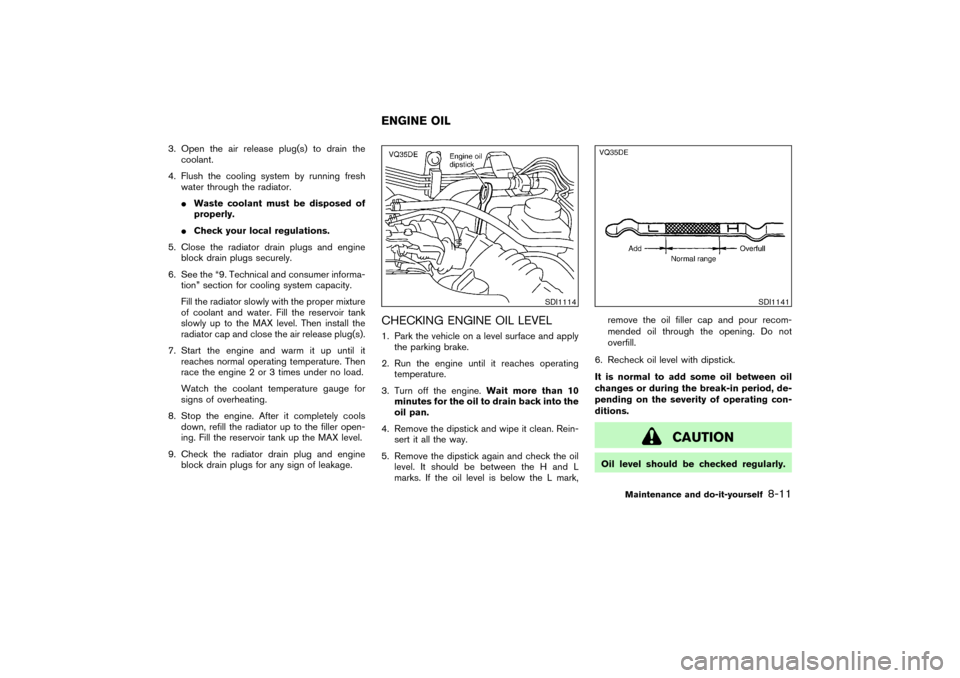
3. Open the air release plug(s) to drain the
coolant.
4. Flush the cooling system by running fresh
water through the radiator.
�Waste coolant must be disposed of
properly.
�Check your local regulations.
5. Close the radiator drain plugs and engine
block drain plugs securely.
6. See the “9. Technical and consumer informa-
tion” section for cooling system capacity.
Fill the radiator slowly with the proper mixture
of coolant and water. Fill the reservoir tank
slowly up to the MAX level. Then install the
radiator cap and close the air release plug(s).
7. Start the engine and warm it up until it
reaches normal operating temperature. Then
race the engine 2 or 3 times under no load.
Watch the coolant temperature gauge for
signs of overheating.
8. Stop the engine. After it completely cools
down, refill the radiator up to the filler open-
ing. Fill the reservoir tank up the MAX level.
9. Check the radiator drain plug and engine
block drain plugs for any sign of leakage.
CHECKING ENGINE OIL LEVEL1. Park the vehicle on a level surface and apply
the parking brake.
2. Run the engine until it reaches operating
temperature.
3. Turn off the engine.Wait more than 10
minutes for the oil to drain back into the
oil pan.
4. Remove the dipstick and wipe it clean. Rein-
sert it all the way.
5. Remove the dipstick again and check the oil
level. It should be between the H and L
marks. If the oil level is below the L mark,remove the oil filler cap and pour recom-
mended oil through the opening. Do not
overfill.
6. Recheck oil level with dipstick.
It is normal to add some oil between oil
changes or during the break-in period, de-
pending on the severity of operating con-
ditions.
CAUTION
Oil level should be checked regularly.
SDI1114
SDI1141
ENGINE OIL
Maintenance and do-it-yourself
8-11
�
04.3.9/R50-D/V5
�
Page 238 of 306
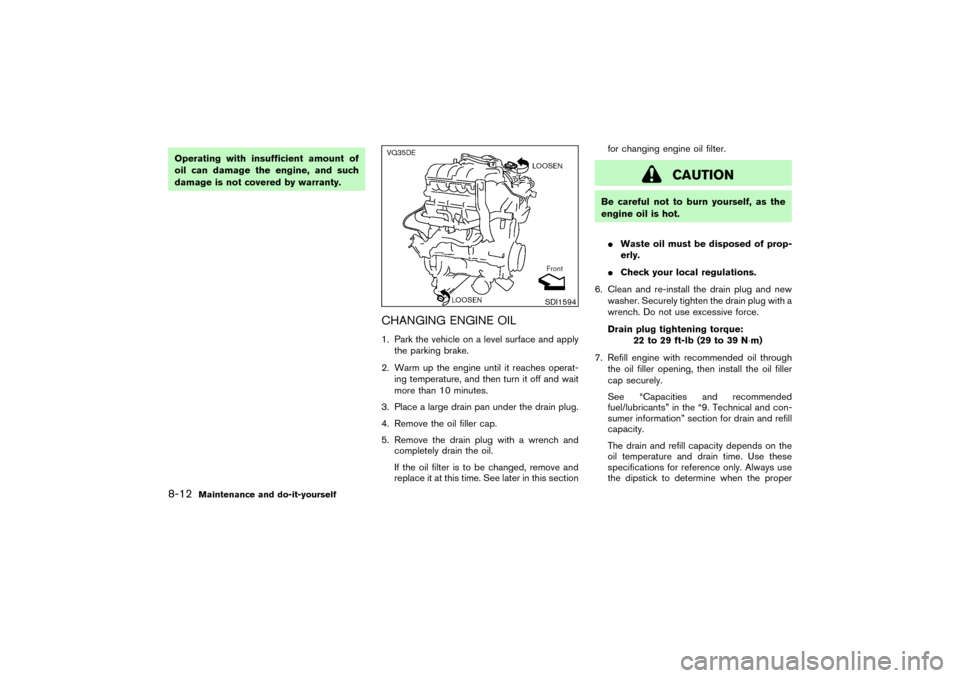
Operating with insufficient amount of
oil can damage the engine, and such
damage is not covered by warranty.
CHANGING ENGINE OIL1. Park the vehicle on a level surface and apply
the parking brake.
2. Warm up the engine until it reaches operat-
ing temperature, and then turn it off and wait
more than 10 minutes.
3. Place a large drain pan under the drain plug.
4. Remove the oil filler cap.
5. Remove the drain plug with a wrench and
completely drain the oil.
If the oil filter is to be changed, remove and
replace it at this time. See later in this sectionfor changing engine oil filter.
CAUTION
Be careful not to burn yourself, as the
engine oil is hot.
�Waste oil must be disposed of prop-
erly.
�Check your local regulations.
6. Clean and re-install the drain plug and new
washer. Securely tighten the drain plug with a
wrench. Do not use excessive force.
Drain plug tightening torque:
22 to 29 ft-lb (29 to 39 N⋅m)
7. Refill engine with recommended oil through
the oil filler opening, then install the oil filler
cap securely.
See “Capacities and recommended
fuel/lubricants” in the “9. Technical and con-
sumer information” section for drain and refill
capacity.
The drain and refill capacity depends on the
oil temperature and drain time. Use these
specifications for reference only. Always use
the dipstick to determine when the proper
SDI1594
8-12
Maintenance and do-it-yourself
�
04.3.9/R50-D/V5
�
Page 239 of 306
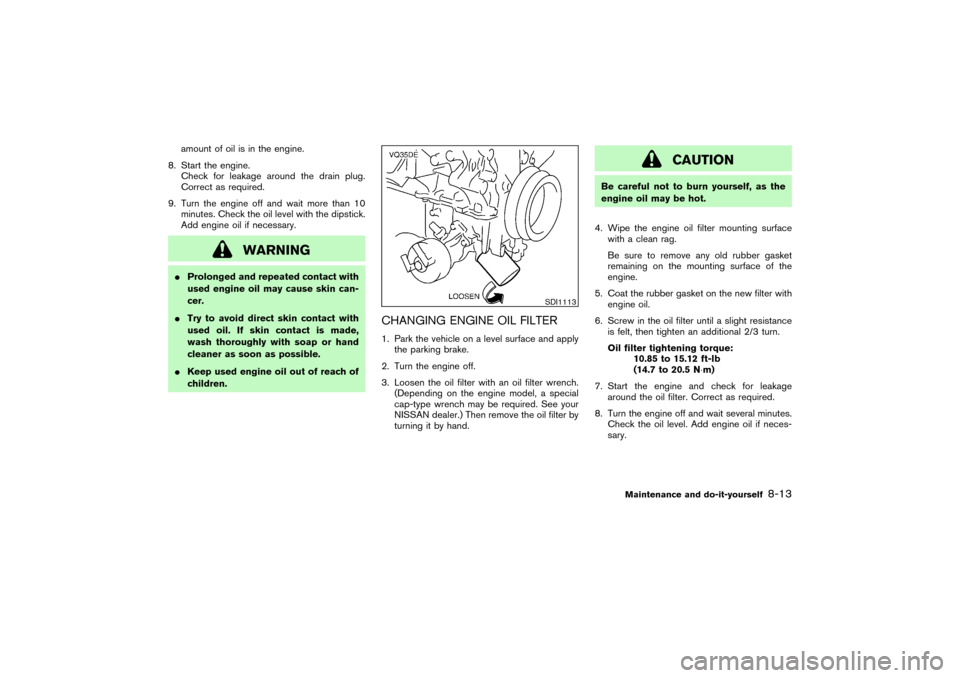
amount of oil is in the engine.
8. Start the engine.
Check for leakage around the drain plug.
Correct as required.
9. Turn the engine off and wait more than 10
minutes. Check the oil level with the dipstick.
Add engine oil if necessary.
WARNING
�Prolonged and repeated contact with
used engine oil may cause skin can-
cer.
�Try to avoid direct skin contact with
used oil. If skin contact is made,
wash thoroughly with soap or hand
cleaner as soon as possible.
�Keep used engine oil out of reach of
children.
CHANGING ENGINE OIL FILTER1. Park the vehicle on a level surface and apply
the parking brake.
2. Turn the engine off.
3. Loosen the oil filter with an oil filter wrench.
(Depending on the engine model, a special
cap-type wrench may be required. See your
NISSAN dealer.) Then remove the oil filter by
turning it by hand.
CAUTION
Be careful not to burn yourself, as the
engine oil may be hot.
4. Wipe the engine oil filter mounting surface
with a clean rag.
Be sure to remove any old rubber gasket
remaining on the mounting surface of the
engine.
5. Coat the rubber gasket on the new filter with
engine oil.
6. Screw in the oil filter until a slight resistance
is felt, then tighten an additional 2/3 turn.
Oil filter tightening torque:
10.85 to 15.12 ft-lb
(14.7 to 20.5 N⋅m)
7. Start the engine and check for leakage
around the oil filter. Correct as required.
8. Turn the engine off and wait several minutes.
Check the oil level. Add engine oil if neces-
sary.
SDI1113
Maintenance and do-it-yourself
8-13
�
04.3.9/R50-D/V5
�
Page 240 of 306
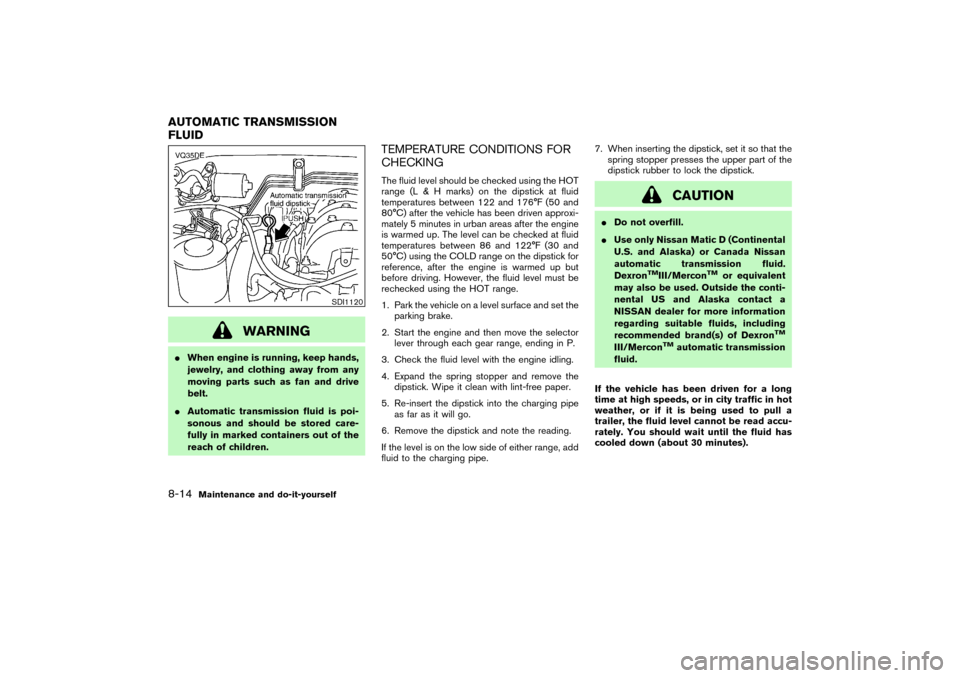
WARNING
�When engine is running, keep hands,
jewelry, and clothing away from any
moving parts such as fan and drive
belt.
�Automatic transmission fluid is poi-
sonous and should be stored care-
fully in marked containers out of the
reach of children.
TEMPERATURE CONDITIONS FOR
CHECKINGThe fluid level should be checked using the HOT
range (L & H marks) on the dipstick at fluid
temperatures between 122 and 176°F (50 and
80°C) after the vehicle has been driven approxi-
mately 5 minutes in urban areas after the engine
is warmed up. The level can be checked at fluid
temperatures between 86 and 122°F (30 and
50°C) using the COLD range on the dipstick for
reference, after the engine is warmed up but
before driving. However, the fluid level must be
rechecked using the HOT range.
1. Park the vehicle on a level surface and set the
parking brake.
2. Start the engine and then move the selector
lever through each gear range, ending in P.
3. Check the fluid level with the engine idling.
4. Expand the spring stopper and remove the
dipstick. Wipe it clean with lint-free paper.
5. Re-insert the dipstick into the charging pipe
as far as it will go.
6. Remove the dipstick and note the reading.
If the level is on the low side of either range, add
fluid to the charging pipe.7. When inserting the dipstick, set it so that the
spring stopper presses the upper part of the
dipstick rubber to lock the dipstick.
CAUTION
�Do not overfill.
�Use only Nissan Matic D (Continental
U.S. and Alaska) or Canada Nissan
automatic transmission fluid.
Dexron
TMIII/Mercon
TM
or equivalent
may also be used. Outside the conti-
nental US and Alaska contact a
NISSAN dealer for more information
regarding suitable fluids, including
recommended brand(s) of Dexron
TM
III/Mercon
TM
automatic transmission
fluid.
If the vehicle has been driven for a long
time at high speeds, or in city traffic in hot
weather, or if it is being used to pull a
trailer, the fluid level cannot be read accu-
rately. You should wait until the fluid has
cooled down (about 30 minutes).
SDI1120
AUTOMATIC TRANSMISSION
FLUID8-14
Maintenance and do-it-yourself
�
04.3.9/R50-D/V5
�
Page 241 of 306
Check the fluid level.
The fluid level should be checked using the HOT
range on the dipstick at fluid temperatures of
122 to 176°F (50 to 80°C) or using the COLD
range on the dipstick at fluid temperatures of 32
to 86°F (0 to 30°C).
Check the fluid level.
CAUTION
�Do not overfill.
�Use Genuine Nissan PSF or equiva-lent.
SDI1209
DI0187M
POWER STEERING FLUID
Maintenance and do-it-yourself
8-15
�
04.3.9/R50-D/V5
�
Page 242 of 306
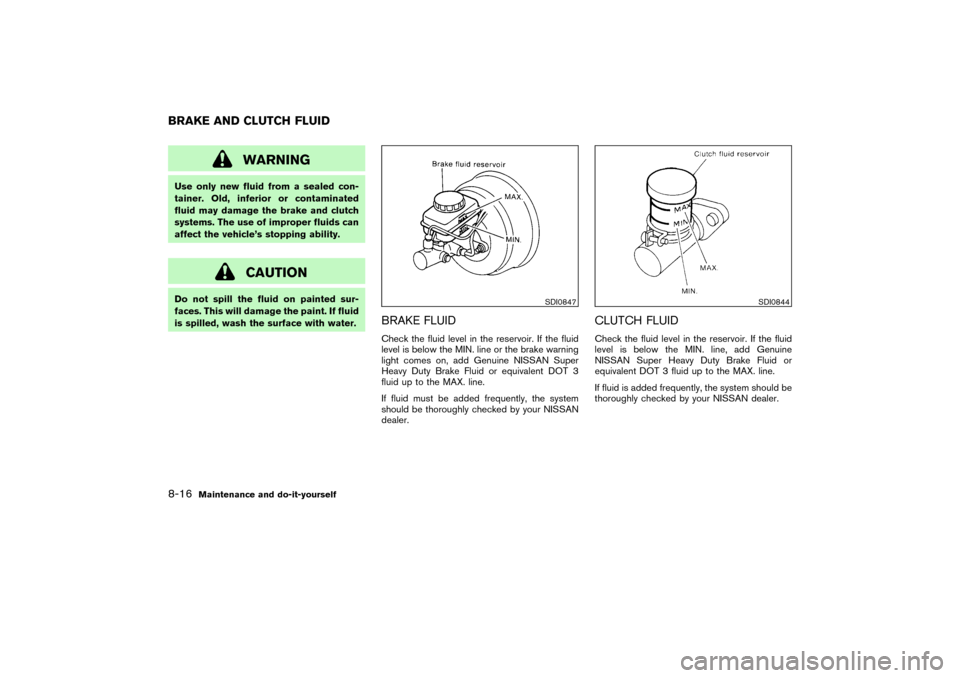
WARNING
Use only new fluid from a sealed con-
tainer. Old, inferior or contaminated
fluid may damage the brake and clutch
systems. The use of improper fluids can
affect the vehicle’s stopping ability.
CAUTION
Do not spill the fluid on painted sur-
faces. This will damage the paint. If fluid
is spilled, wash the surface with water.
BRAKE FLUIDCheck the fluid level in the reservoir. If the fluid
level is below the MIN. line or the brake warning
light comes on, add Genuine NISSAN Super
Heavy Duty Brake Fluid or equivalent DOT 3
fluid up to the MAX. line.
If fluid must be added frequently, the system
should be thoroughly checked by your NISSAN
dealer.
CLUTCH FLUIDCheck the fluid level in the reservoir. If the fluid
level is below the MIN. line, add Genuine
NISSAN Super Heavy Duty Brake Fluid or
equivalent DOT 3 fluid up to the MAX. line.
If fluid is added frequently, the system should be
thoroughly checked by your NISSAN dealer.
SDI0847
SDI0844
BRAKE AND CLUTCH FLUID8-16
Maintenance and do-it-yourself
�
04.3.9/R50-D/V5
�
Page 243 of 306
WINDOW WASHER FLUID
RESERVOIR
For USTo check the fluid level, use your finger to plug
the center hole of the cap/tube assembly (as
shown above), then remove it from the tank. If
there is no fluid in the tube, add fluid. Add a
washer solvent to the water for better cleaning.
In the winter season, add a windshield washer
anti-freeze. Follow the manufacturer’s instruc-
tions for the mixture ratio.
For CANADAAdd fluid when the low washer fluid warning light
comes on. Add a washer solvent to the water for
better cleaning. In the winter season, add a
windshield washer anti-freeze. Follow the manu-
facturer’s instructions for the mixture ratio.
CAUTION
Do not substitute engine anti-freeze
coolant for window washer solution.
This may result in damage to the paint.
WARNING
Anti-freeze is poisonous and should be
stored carefully marked containers out
of the reach of children.
SDI0423A
SDI0389
WINDOW WASHER FLUID
Maintenance and do-it-yourself
8-17
�
04.3.9/R50-D/V5
�
Page 244 of 306
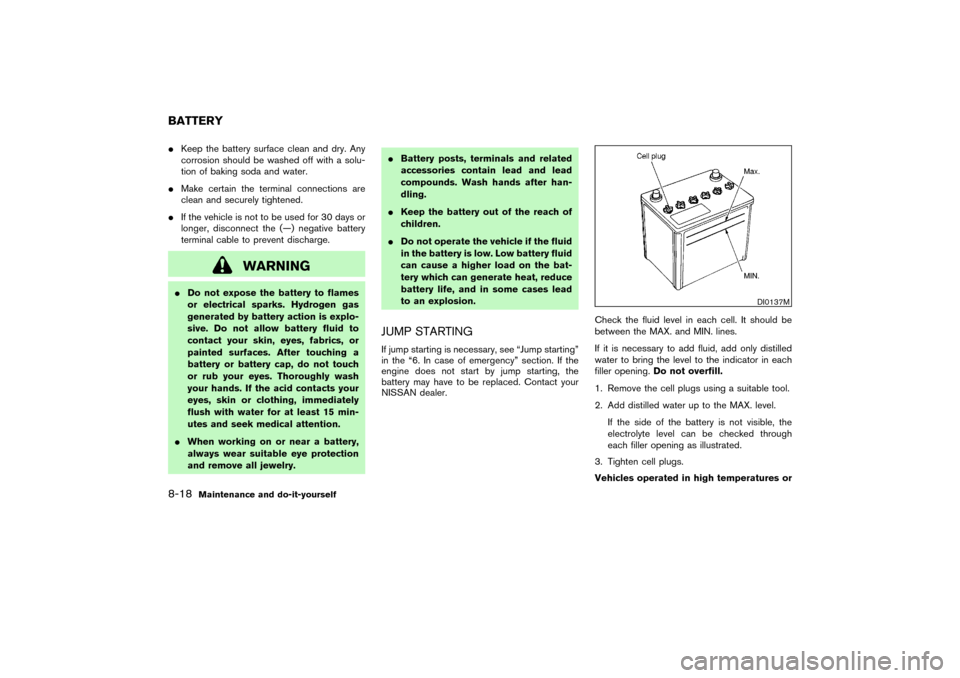
�Keep the battery surface clean and dry. Any
corrosion should be washed off with a solu-
tion of baking soda and water.
�Make certain the terminal connections are
clean and securely tightened.
�If the vehicle is not to be used for 30 days or
longer, disconnect the (—) negative battery
terminal cable to prevent discharge.
WARNING
�Do not expose the battery to flames
or electrical sparks. Hydrogen gas
generated by battery action is explo-
sive. Do not allow battery fluid to
contact your skin, eyes, fabrics, or
painted surfaces. After touching a
battery or battery cap, do not touch
or rub your eyes. Thoroughly wash
your hands. If the acid contacts your
eyes, skin or clothing, immediately
flush with water for at least 15 min-
utes and seek medical attention.
�When working on or near a battery,
always wear suitable eye protection
and remove all jewelry.�Battery posts, terminals and related
accessories contain lead and lead
compounds. Wash hands after han-
dling.
�Keep the battery out of the reach of
children.
�Do not operate the vehicle if the fluid
in the battery is low. Low battery fluid
can cause a higher load on the bat-
tery which can generate heat, reduce
battery life, and in some cases lead
to an explosion.
JUMP STARTINGIf jump starting is necessary, see “Jump starting”
in the “6. In case of emergency” section. If the
engine does not start by jump starting, the
battery may have to be replaced. Contact your
NISSAN dealer.Check the fluid level in each cell. It should be
between the MAX. and MIN. lines.
If it is necessary to add fluid, add only distilled
water to bring the level to the indicator in each
filler opening.Do not overfill.
1. Remove the cell plugs using a suitable tool.
2. Add distilled water up to the MAX. level.
If the side of the battery is not visible, the
electrolyte level can be checked through
each filler opening as illustrated.
3. Tighten cell plugs.
Vehicles operated in high temperatures or
DI0137M
BATTERY8-18
Maintenance and do-it-yourself
�
04.3.9/R50-D/V5
�